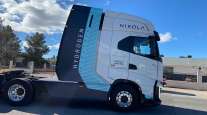Senior Reporter
Fuel Cells Can Reduce Cost of Maintenance, Nikola Says

This story appears in the Dec. 12 print edition of Transport Topics.
Among the advantages Nikola Motor Co. touted when it unveiled the industry’s first Class 8 electric truck running on a hydrogen fuel cell and battery pack was the ability to significantly reduce fleet maintenance expenses.
Monthly maintenance with its truck would drop to 6 cents per mile from the 12 cents that fleets with diesel engines spend, Nikola said.
“The cost for bringing in a unit for regular maintenance diminishes rapidly,” said Gerry Mead, senior vice president of maintenance at U.S. Xpress Inc. For example, there is no need to change oil regularly or ensure the regeneration cycle of the diesel particulate filters is accomplished, he said.
U.S. Xpress Enterprises, parent of U.S. Xpress Inc., ranks No. 19 on the Transport Topics Top 100 list of the largest U.S. and Canadian for-hire carriers.
Nikola said the fuel cell charges the truck’s 320 kilowatt-hour battery pack, which powers the electric motors that drive the wheels, for example. The fuel cell runs on 100% zero-emissions hydrogen gas stored onboard in a pressurized tank that can hold about 165 pounds to 220 pounds of the fuel.
When power is needed, hydrogen can be sent to the fuel cell. It encounters catalysts, the chemical reaction strips electrons from the gas and these are passed by direct current to the battery, charging it.
Afterward, the hydrogen molecules (ions) are mixed with ambient air, which is combined with the previously stripped electrons to create the byproduct of the process — water, which leaves via the tailpipe.
Nikola anticipates production on Nikola One to begin in 2020 and said that Ryder System Inc. would be its primary distribution and maintenance provider. Ryder has a network of more than 800 North American service locations.
“It’s a different configuration than anything that the industry has seen, from a conventional diesel engine with a transmission, with a drive shaft going to differentials, axles and wheel ends. A lot of that is eliminated,” Scott Perry, chief technology and procurement officer for Ryder’s fleet management solutions division, told TT.
“I think it is a much more sophisticated technology but a much simpler technology with regard to the number of moving parts and the integration of systems,” he said.
Ryder Supply Chain Solutions ranks No. 13 on the for-hire TT100.
Nikola anticipates the fuel cell will run 50% of the time. But that will depend on terrain, load to motors, battery longevity, battery level and hybrid features such as regenerative braking, according to the company.
Nikola plans to build 364 hydrogen fueling stations across the United States and Canada, which will break ground in January 2018.
Class 8 manufacturers asked to comment on the technology did not respond, including Paccar Inc.’s Kenworth Truck Co., which is involved in a fuel-cell electric truck pilot project in California.
Automaker Toyota Motor North America is involved in a California-based feasibility study on Class 8 hydrogen fuel cells but did not elaborate. “We will make some further announcements next year. I think at that time it will be very interesting for everyone to see what we have been up to,” Craig Scott, director of advanced technology vehicles for Toyota Motor North America, told TT.
General maintenance on Toyota’s Mirai, a hydrogen fuel cell-powered passenger car, includes checking the tires and brake pads, and the fluid to cool the electric motor and the fuel cell stack, “and that is changed once a year,” he said.
However, Cummins Inc., the industry’s only independent engine maker, commended Nikola for trying to push the boundaries of the possible.
“Essentially, if the fuel cell becomes a viable commercial proposition for Class 8 applications, we have the ability to transition our emerging vehicle electric capability over to a hydrogen power source,” Cummins said in a statement. “There are, however, many barriers to be overcome before we reach that option, not least in terms of a fueling infrastructure.”




